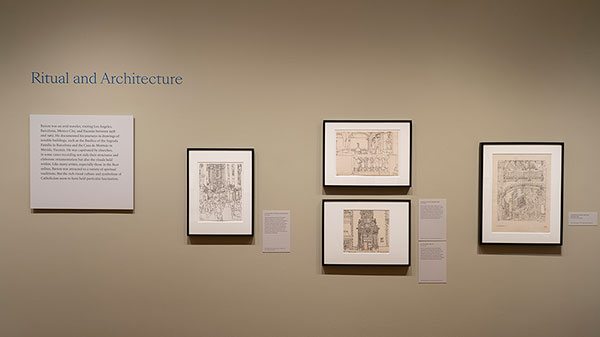Ritual and Architecture
Barton was an avid traveler, visiting Los Angeles, Barcelona, Mexico City, and Yucatán between 1958 and 1962. He documented his journeys in drawings of notable buildings, such as the Basílica of the Sagrada Família in Barcelona and the Casa de Montejo in Mérida, Yucatán. He was captivated by churches, in some cases recording not only their structures and elaborate ornamentation but also the rituals held within. Like many artists, especially those in the Beat milieu, Barton was attracted to a variety of spiritual traditions. But the rich visual culture and symbolism of Catholicism seem to have held particular fascination.
La reina de Mexico (The Queen of Mexico)
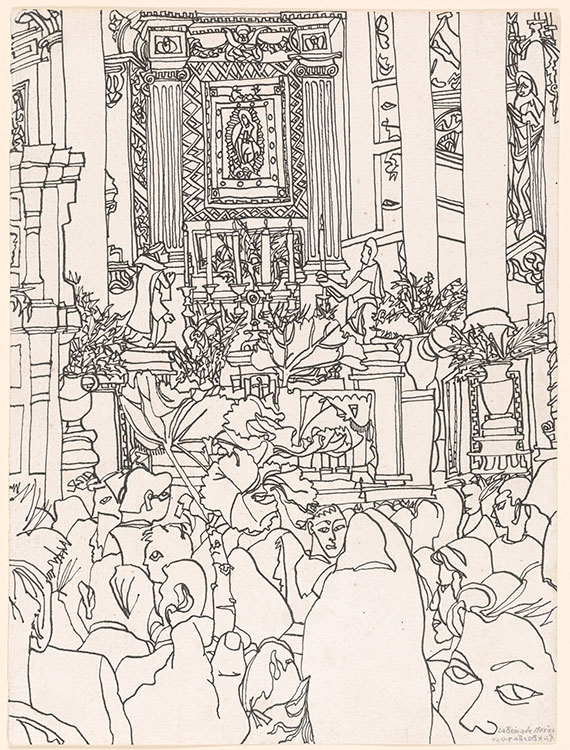
This drawing shows a throng of the faithful gathered in the nave of a church, almost certainly the Basilica of Our Lady of Guadalupe in Mexico City. The consistency of Barton’s line tends to flatten his images, but close observation reveals a thumb in the composition’s foreground, in the manner of a photographer who has accidentally obscured the lens. Just beyond and to the left, a hand holds a stem, perhaps referencing the roses in the origin story of the Virgin of Guadalupe.
Rick Barton (1928–1992)
La reina de Mexico (The Queen of Mexico), 1960
Pen and ink
The Morgan Library & Museum, gift of William and
Norma Anthony; 2017.278
Barcelona, August 28, 1962
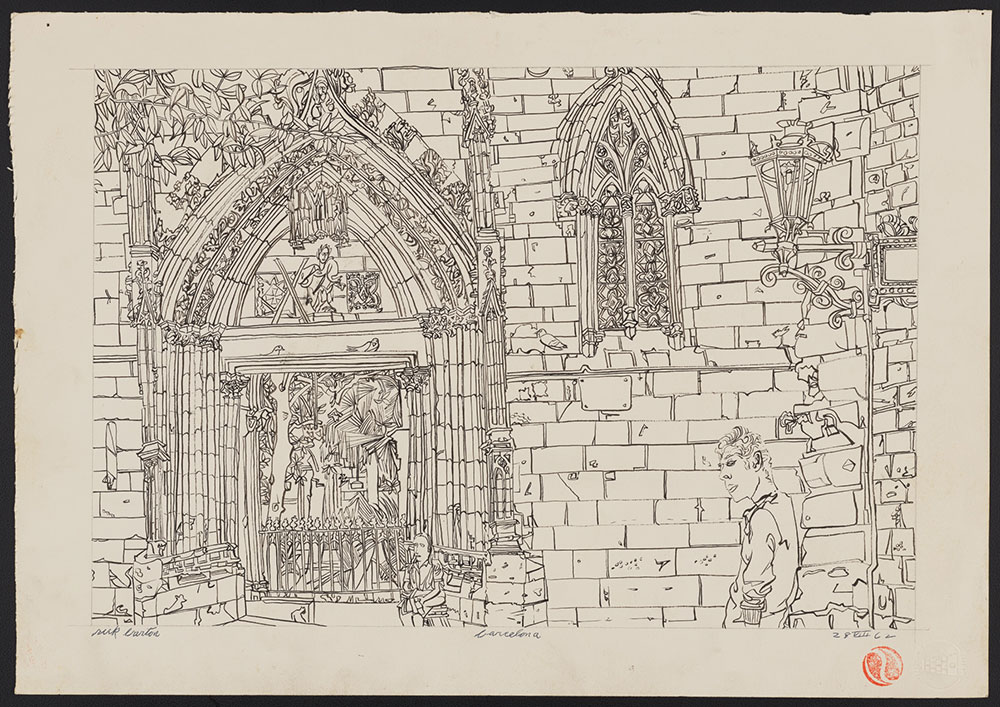
Rick Barton (1928–1992)
Barcelona, August 28, 1962
Pen and ink with graphite
Rick Barton papers (Collection 2374), UCLA Library Special Collections, Charles E. Young Research Library, University of California, Los Angeles
Untitled [Basílica of the Sagrada Família, Barcelona]

Rick Barton (1928–1992)
Untitled [Basílica of the Sagrada Família, Barcelona], September 1962
Pen and ink with graphite
Rick Barton papers (Collection 2374), UCLA Library Special Collections, Charles E. Young Research Library, University of California, Los Angeles
Untitled [Façade of Barcelona Cathedral]

Rick Barton (1928–1992)
Untitled [Façade of Barcelona Cathedral], September 1962
Pen and ink with graphite
Rick Barton papers (Collection 2374), UCLA Library Special Collections, Charles E. Young Research Library, University of California, Los Angeles
Untitled [Cloister in Barcelona Cathedral]
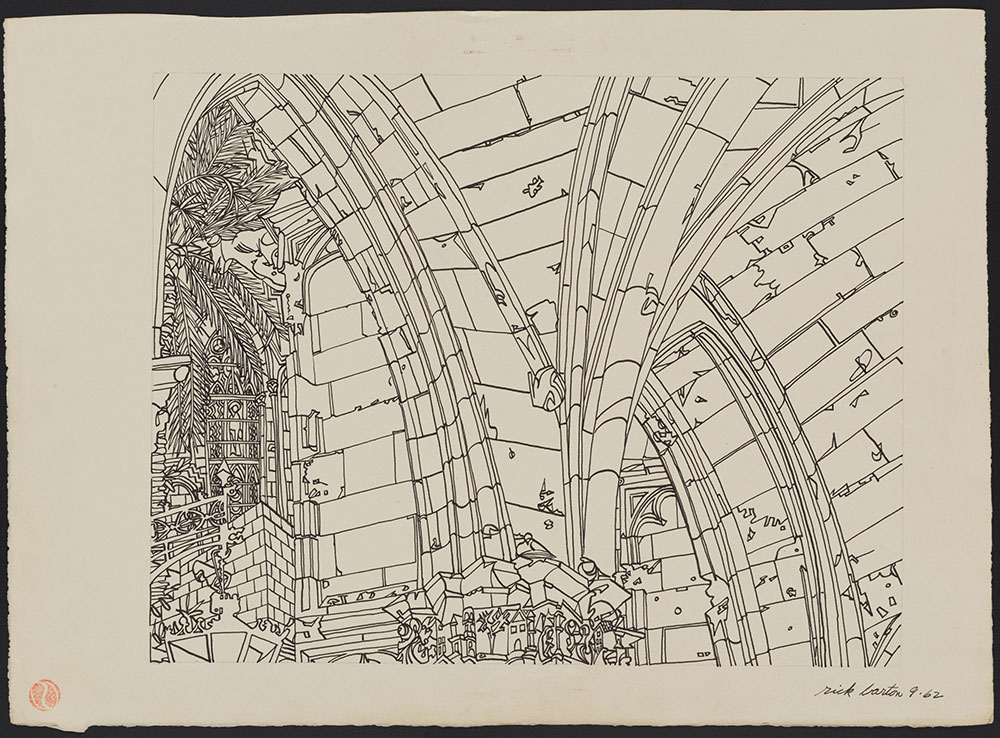
Rick Barton (1928–1992)
Untitled [Cloister in Barcelona Cathedral], September 1962
Pen and ink with graphite
Rick Barton papers (Collection 2374), UCLA Library Special Collections, Charles E. Young Research Library, University of California, Los Angeles
Untitled [Interior of Barcelona Cathedral withseated man]

Rick Barton (1928–1992)
Untitled [Interior of Barcelona Cathedral with
seated man], September 1962
Pen and ink with graphite
Rick Barton papers (Collection 2374), UCLA Library Special Collections, Charles E. Young Research Library, University of California, Los Angeles
Untitled [Pont del Bisbe, Barcelona]
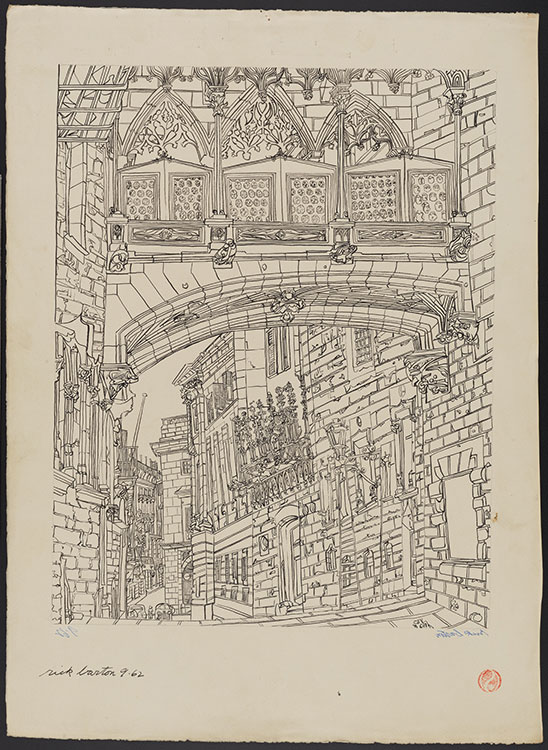
Rick Barton (1928–1992)
Untitled [Pont del Bisbe, Barcelona],
September 1962
Pen and ink with graphite
Rick Barton papers (Collection 2374), UCLA Library Special Collections, Charles E. Young Research Library, University of California, Los Angeles
Academia San Carlos
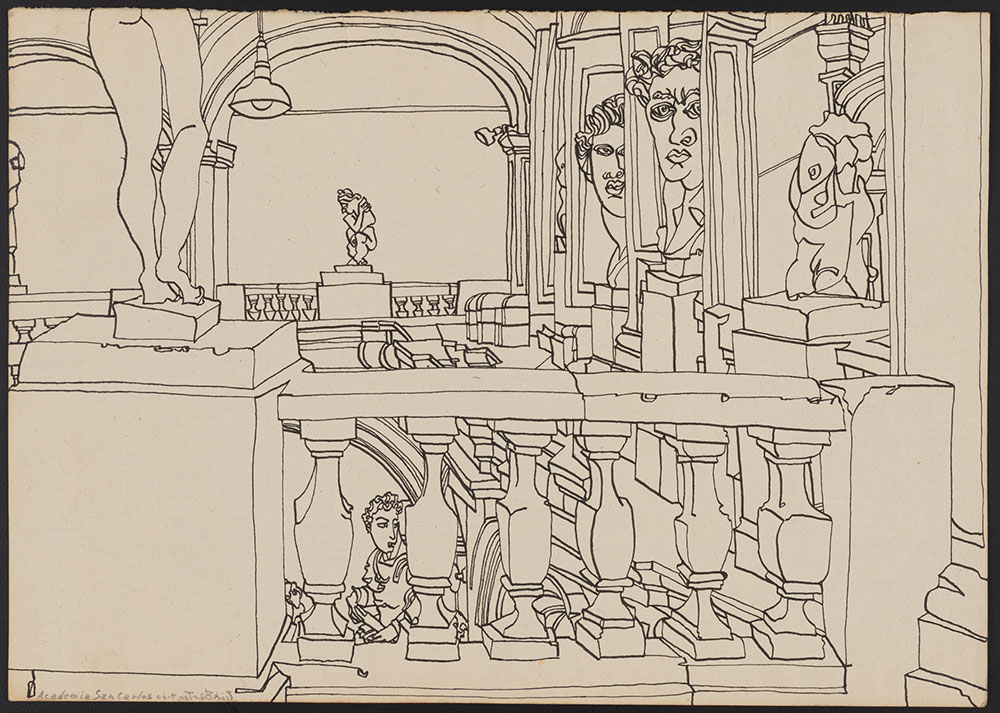
Barton made this drawing in Mexico City, at the Academy of San Carlos. Founded in 1785 by Carlos III, king of Spain, it was the first art academy of its kind in the Americas. Since 1791 the academy has inhabited a sixteenth-century building that was previously a hospital. In this drawing of the interior, Barton focused his attention on the Neoclassical plaster casts of ancient sculptures that line the balcony.
Rick Barton (1928–1992)
Academia San Carlos, September 1960
Pen and ink
Rick Barton papers (Collection 2374), UCLA Library Special Collections, Charles E. Young Research Library, University of California, Los Angeles
Casa de Montejo

Barton incorporated an unusually lengthy inscription into this drawing, writing in red ink: “the doorway to the most beautiful house from new york west to china and south to merida, yucatán, mexico, the casa de montejo.” The Casa de Montejo is a sixteenth-century building located on the central square in Mérida, the capital of the Mexican state of Yucatán.
Rick Barton (1928–1992)
Casa de Montejo, 1960–61
Pen and ink
Rick Barton papers (Collection 2374), UCLA Library Special Collections, Charles E. Young Research Library, University of California, Los Angeles
God Foil [?]

Rick Barton (1928–1992)
God Foil [?], April 23, 1960
Pen and ink
Rick Barton papers (Collection 2374), UCLA Library Special Collections, Charles E. Young Research Library, University of California, Los Angeles
Delicatessen Art
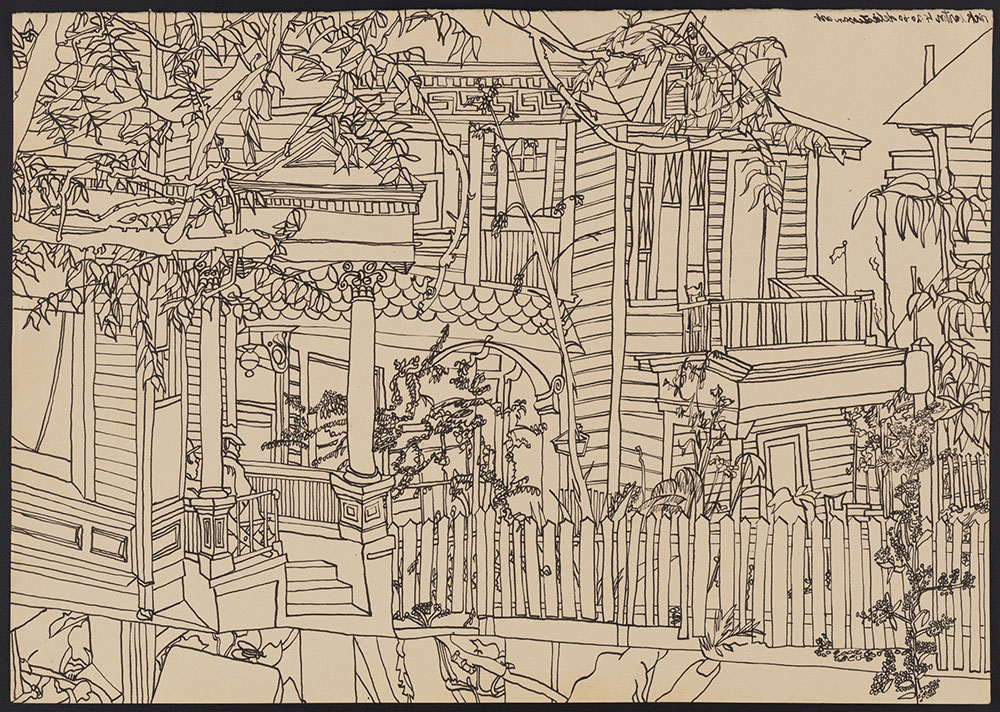
Rick Barton (1928–1992)
Delicatessen Art, April 20, 1960
Pen and ink
Rick Barton papers (Collection 2374), UCLA Library Special Collections, Charles E. Young Research Library, University of California, Los Angeles
The Great Mass
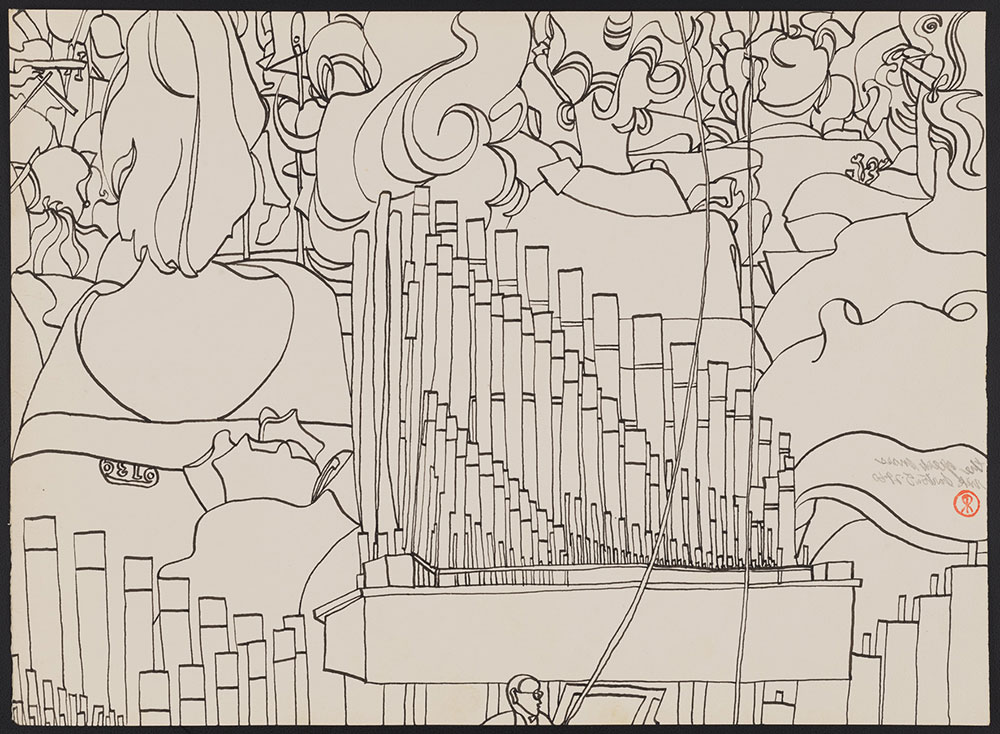
Rick Barton (1928–1992)
The Great Mass, May 29, 1960
Pen and ink
Rick Barton papers (Collection 2374), UCLA Library Special Collections, Charles E. Young Research Library, University of California, Los Angeles
San Francisco Churches, plate 1

Although postwar San Francisco is remembered as a bastion of counterculture, Catholics formed a significant segment of the population, as attested by the abundance of churches. In this portfolio Barton recorded seven houses of worship. Each plate features a building surrounded by saints, angels, and scenes from the New Testament, a format reminiscent of Byzantine icons. Whereas icons typically center on an image of a saint, Barton gave the buildings themselves the place of honor. His approach was clearly expressive rather than exacting, but a colophon naming each church and its intersection reveals Barton’s desire to represent specific structures.
Rick Barton (1928–1992)
San Francisco Churches, plate 1: Holy Trinity, Van Ness and Green
San Francisco: Porpoise Bookshop, 1959
7 linoleum block prints in portfolio, edition of 80
The Morgan Library & Museum, gift of William and Norma Anthony; 2017.335:1
San Francisco Churches, plate 2

Rick Barton (1928–1992)
San Francisco Churches: Our Lady of Kazan, 20th and California
San Francisco: Published at the Porpoise Bookshop, 308 Clement
Street, 1959
The Morgan Library & Museum, gift of William and Norma Anthony
San Francisco Churches, plate 5

Rick Barton (1928–1992)
San Francisco Churches, plate 5: Vedanta Temple, Webster near Filbert
San Francisco: Porpoise Bookshop, 1959
7 linoleum block prints in portfolio, edition of 80
The Morgan Library & Museum, gift of William and Norma Anthony; 2017.335:5
San Francisco Churches, plate 6
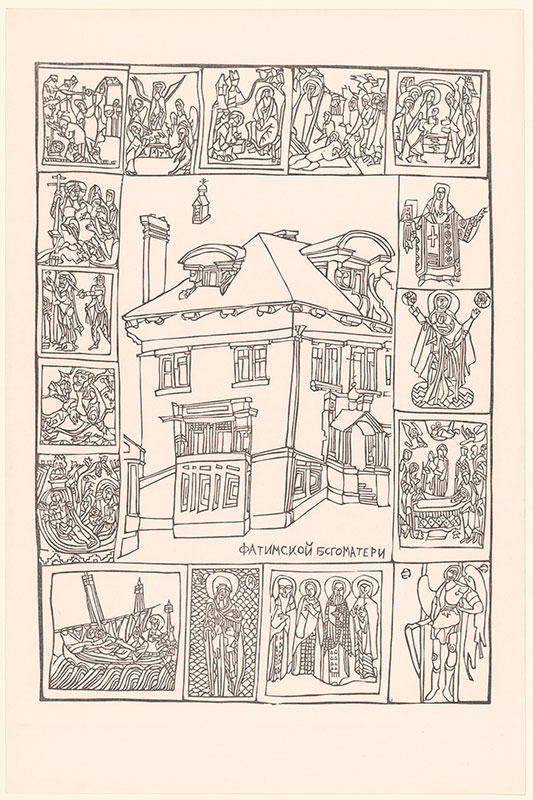
Rick Barton (1928–1992)
San Francisco Churches, plate 6: Our Lady of Fatima, 20th and Lake
San Francisco: Porpoise Bookshop, 1959
7 linoleum block prints in portfolio, edition of 80
The Morgan Library & Museum, gift of William and Norma Anthony; 2017.335:6
San Francisco Churches, plate 7
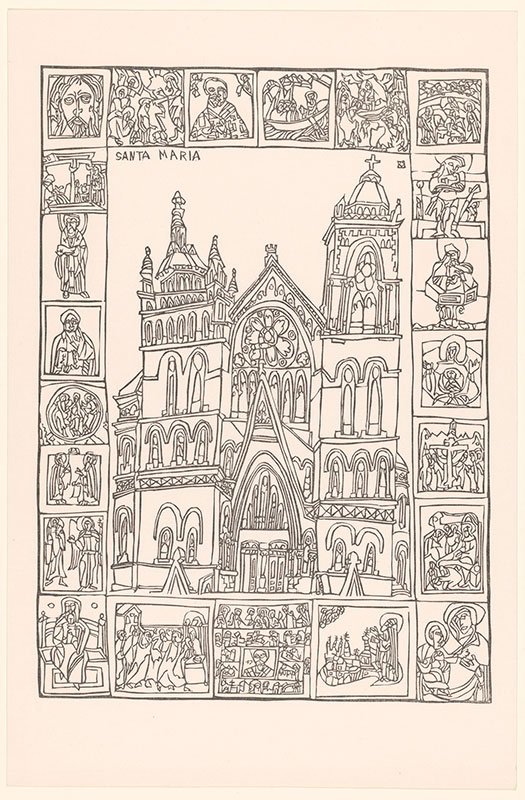
Rick Barton (1928–1992)
San Francisco Churches, plate 7: St. Mary’s, Van Ness and O’Farrell
San Francisco: Porpoise Bookshop, 1959
7 linoleum block prints in portfolio, edition of 80
The Morgan Library & Museum, gift of William and Norma Anthony; 2017.335:7
Linoleum block for St. Mary’s, Van Ness andO’Farrel

Barton produced all his prints using linoleum blocks such as this one. Henry Evans, who introduced Barton to the form and printed his works, recalled, “I gave [Barton] tools and materials and it was very soon like a re-enactment of the sorcerer’s apprentice. I’d give him a dozen pieces of linoleum on a Friday and Monday he’d show up with them all ready to mount on bases and print.”
Rick Barton (1928–1992)
Linoleum block for St. Mary’s, Van Ness and
O’Farrell, plate 7 of San Francisco Churches, 1959
Peregrine Press and Henry H. Evans Collection, William
Andrews Clark Memorial Library, University of California,
Los Angeles
